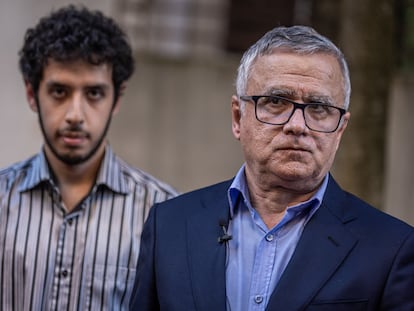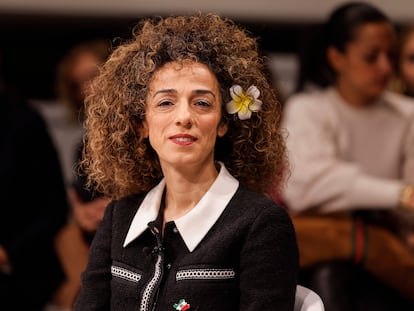Marjane Satrapi, illustrator and filmmaker: ‘Iran is experiencing the world’s first feminist revolution’
The author of ‘Persepolis’ — alongside fellow writers and illustrators — has published the graphic novel ‘Woman, Life, Freedom’ about the revolt in Iran following the death of 22-year-old Mahsa Amini, who died in police custody
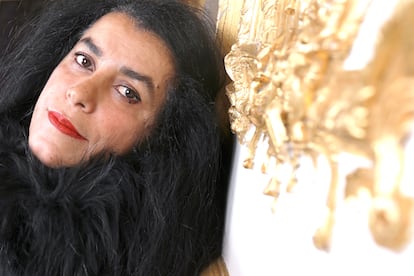
Marjane Satrapi returns. After years away from comics — the art that brought her massive praise from both critics and the public — the author of the acclaimed Persepolis has returned to drawing and writing. “There was something important to say,” Satrapi explains, in the living room of her home in Paris. The 54-year-old Iranian-born graphic novelist hosted EL PAÍS on Tuesday, November 28. “Drawing is the human being’s first [artistic] expression, before writing.”
The cartoonist and filmmaker wanted to narrate the death of Mahsa Amini, the 22-year-old woman who was detained by Iran’s morality police for not wearing her veil correctly. Head coverings are mandatory for women in Iran. Satrapi wanted to say something about this and about what came afterwards: a wave of protests and brutal repression. “Mahsa Amini will forever be the symbol of the fight for freedom. She died [because she wore] the veil incorrectly,” Satrapi notes, before adding that “Iran is experiencing the world’s first feminist revolution.”
At the initiative of the late French editor Sophie de Sivry, Satrapi brought together three specialists — political scientist Farid Vahid and historian Abbas Milani, both Iranians, as well as veteran French reporter Jean-Pierre Perrin — and a dream team of 17 comic authors, including several Iranians and Spaniards. The result is Woman, Life, Freedom, title of the publication, which takes its name from the motto of the revolution.
“Signing manifestos is great, but it has little mileage,” she explains. “But a book lasts.” However, at another point in the conversation, she clarifies: “You have to be humble about the influence of a book, a song, or a movie. I sold millions of copies of Persepolis (which can be purchased in two volumes, or as a complete book) and I don’t know how many hundreds of conferences I gave. Did I change anything? How would I know? Did I arouse people’s curiosity? Yes. I contributed a little. Just a little bit… but that’s the only way to change the world.”
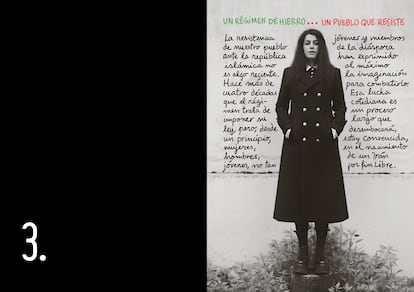
From interviews with Marjane Satrapi, we always come away with the same feeling: that the character who appears in her comics is, in fact, the creator. She has the same whirlwind of ideas, the same clarity of principles… and the same iron character. As soon as Satrapi enters her apartment — and upon seeing the photographer from EL PAÍS — she announces that she refuses to be photographed. “It’s not to act interesting,” she clarifies. “Every time someone takes a photo of me, I feel a little like the [Indigenous people] of the 19th century… I have the impression that [the cameras] are stealing my soul. I don’t even let my friends take photos of me. And, if they do, I take away their phone and I delete it.”
Three years ago, during her last interview with EL PAÍS — in which she allowed herself to be photographed — she said: “I no longer feel like making comics. And, if you don’t feel like doing something, it’s better not to do it.”
“Actually, even now, I haven’t done any comics,” the author clarifies “I’ve done a double-page illustration and the cover art. That’s it.” It’s not a little. In all the pages of Woman, Life, Freedom, which is much more than a protest book or a non-fiction comic, you can feel the strength of this indomitable artist, who came to France to study and created a classic graphic novel. On the cover of the new book, you can see a group of faces: women with their hair in the air, as if it were a bonfire. And there are men next to them. “A big difference is that, this time around, the Woman, Life, Freedom movement is supported by men, because women’s rights are the rights of society.”
Satrapi illustrates the chapter Feared and Hated, about the Guardians of the Revolution. “They’re not called the Guardians of Iran,” she observes. “This regime doesn’t love Iran. They don’t dress like Iranians or talk like Iranians. Iran, to them, doesn’t mean a damn thing.”
She insists that, in Iran, a minority has held the majority hostage for almost half-a-century. The country has advanced and modernized, while the regime has remained frozen in time, or gone backwards. She says that women – protagonists of the recent revolt – got educated and fought to achieve basic freedoms in the face of misogynistic and corrupt religious authorities and bureaucrats. “They’re a minority and don’t represent even 15% [of the population]. Among them are the religious lunatics, but also a large part of people with economic interests,” Satrapi affirms. “And these people, are they interested in making changes? And, if they did go, [what would be their model]? They would look to China, Venezuela, Russia... they violently cling to power and that’s how it works.”
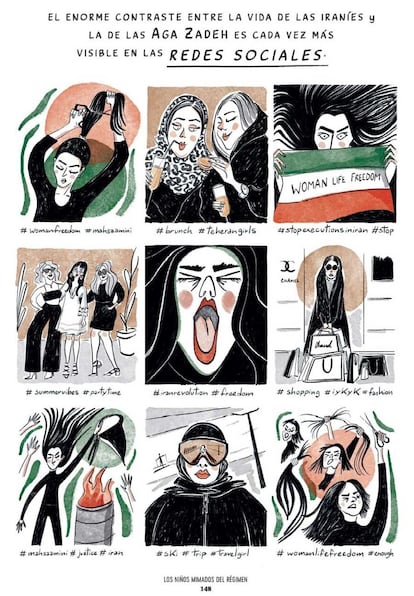
As in Persepolis, the veil is almost a protagonist in Woman, Life, Freedom. “In March of 1979 [the year of the Iranian Revolution], women were already in the streets to say: ‘We don’t want to wear a veil.’ But there weren’t many men [participating] then. The revolutionary left said: ‘The veil isn’t our problem, because we’re facing a problem of social classes.’” But she’s quite clear on this point: “The veil is a symbol of women’s submission. It means saying: ‘I am a sexual object, I must cover myself up because, if not, a man will get an erection.’ And it starts at six years old, because at that age, you can already excite a man. You see the perversity of the thing…” For Satrapi, “removing the veil is important” and she regrets that “neither the left nor the feminists in the West support us, because they’ve gotten it into their heads that Islamism and Muslims are the same: if they attack the [the Islamist ideology], they’re attacking Muslims.”
The director of films such as Radioactive (2019) isn’t happy with a part of feminism. “I’m a factual feminist, not a castrator,” she shrugs. “I’ve always refused to go to women’s literature or film festivals. Both the films and the books,” she adds, pointing to her head, “I make them with this part of my body. My tits and my vagina have nothing to do with this [artistic production]. If I’m appreciated, I want it to be as a filmmaker, not as a man, woman, or hermaphrodite. If there are festivals for men and women, let’s make them for Blacks and whites. Or for the short and tall, because, I assure you, if you’re [five feet tall] or [six feet tall], you won’t have the same vision of the world. These are ghettos! This kind of feminism doesn’t interest me at all.”
In the final chapter of Woman, Life, Freedom, Satrapi talks with co-authors Vahd, Perrin and Milani. Joann Sfar illustrates and narrates the scene. At one point, Satrapi makes a comment about the protests in Iran: “It’s like an avalanche. The snowball is too big. It can’t be stopped.” Then, she predicts that the regime will fall: “They’ve celebrated their 45 years… they won’t reach 50.”
“When I say that the regime is dead,” she clarifies, in her conversation with EL PAÍS, “it’s not because I have a fantasy or am hoping that my wishes become reality, or because I’m optimistic. How can we be optimistic if we’re all going to die? But really, if you see the cultural revolution that has already taken place, this youth that aspires to freedom — this [group of youngsters] that has always been the most pro-democratic and pro-Western in the region — the position of women and the consideration that women have for the [Iranian] men… you put it all together and you conclude that the regime cannot stand.”
The events of the last year and what may come have altered her expectations. Until the death of Mahsa Amini at the hands of the regime — and after 23 years without setting foot in Iran — Satrapi doubted that she would ever return. She even made a will stating that she should be buried there. But everything has changed: “Now, I know I will go back.”
Sign up for our weekly newsletter to get more English-language news coverage from EL PAÍS USA Edition
Tu suscripción se está usando en otro dispositivo
¿Quieres añadir otro usuario a tu suscripción?
Si continúas leyendo en este dispositivo, no se podrá leer en el otro.
FlechaTu suscripción se está usando en otro dispositivo y solo puedes acceder a EL PAÍS desde un dispositivo a la vez.
Si quieres compartir tu cuenta, cambia tu suscripción a la modalidad Premium, así podrás añadir otro usuario. Cada uno accederá con su propia cuenta de email, lo que os permitirá personalizar vuestra experiencia en EL PAÍS.
¿Tienes una suscripción de empresa? Accede aquí para contratar más cuentas.
En el caso de no saber quién está usando tu cuenta, te recomendamos cambiar tu contraseña aquí.
Si decides continuar compartiendo tu cuenta, este mensaje se mostrará en tu dispositivo y en el de la otra persona que está usando tu cuenta de forma indefinida, afectando a tu experiencia de lectura. Puedes consultar aquí los términos y condiciones de la suscripción digital.
More information
Archived In
Últimas noticias
There is as much life left to discover on planet Earth as that which is already known
Dozens presumed dead, around 100 injured in fire at Swiss Alps bar during New Year’s celebration
Is porn for women different from conventional porn? We spoke to those who make it
Cartagena de Indias is sinking: What can the city do to mitigate it?
Most viewed
- Reinhard Genzel, Nobel laureate in physics: ‘One-minute videos will never give you the truth’
- David King, chemist: ‘There are scientists studying how to cool the planet; nobody should stop these experiments from happening’
- Oona Chaplin: ‘I told James Cameron that I was living in a treehouse and starting a permaculture project with a friend’
- Sinaloa Cartel war is taking its toll on Los Chapitos
- The Interoceanic Train, the Mexican alternative to the Panama Canal

